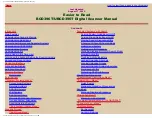
Easier to Read BCD396T/UBCD396T Digital Scanner Manual
Continuous Tone Coded Squelch System (CTCSS) and Digital Coded Squelch (DCS) are two methods used to prevent interference by other radio communications. Your
scanner can receive transmissions that use these codes (or more commonly referred to as tone codes).
CTCSS and DCS systems all use some form of coded squelch. Coded squelch techniques involve the transmission of a special 'code' signal along with the audio of a radio
transmission. A receiver with coded squelch only activates when the received signal has the correct 'code'. This lets many users share a single frequency, and decreases
interference caused by distant transmitters on the same channel. In all major metropolitan areas of the United States, every available radio channel is assigned to more
than one user. Public safety radio systems on the same frequency are usually set up at a distance of 40 miles apart, or more. This means that you may hear transmissions
from a distant system when your local system is not transmitting. By programming the CTCSS tone for a local channel the scanner will not stop on transmissions from the
distant system. With few exceptions, such as the VHF Aircraft and Marine bands, almost every other VHF or UHF radio system uses some form of coded squelch. By far,
CTCSS is the most popular mode among non-trunked systems.
For more information visit Radio Reference's respective pages on
.
Understanding Trunking
Trunking
systems let a large group of 2-way radio users (or even different groups of 2-way radio users) efficiently use a
set
of frequencies. Instead of selecting a specific
frequency for a transmission, the user’s radio selects a programmed trunking bank in the system when that user presses their PTT (push to talk) button. The trunking
system automatically transmits the call on the first available frequency, and also sends (on a different frequency called a Data or Control channel) a code that uniquely
identifies that transmission as a talkgroup ID (or just ID.) So when you are trunktracking a system, you are listening to active IDs transmitting in the system (each using the
first available frequency in the system.) Trunking systems in general allocate and use fewer frequencies among many different users.
Since the trunking system might send a call and its response on different frequencies, it is difficult to listen to trunked communications using a conventional scanner. These
scanners let you monitor the control channel frequency so you can hear calls and responses for users and more easily "follow" conversations than with a conventional
scanner.
These scanners trunktrack the following types of systems:
●
Motorola Type I
●
Motorola Type II
●
Motorola Type IIi Hybrid
●
Motorola Type II Smartnet
●
Motorola Type II Smartzone
●
Motorola Type II Smartzone Omnilink
●
Motorola Type II VOC
●
EDACS Standard (Wide)
●
EDACS Narrowband (Narrow)
●
EDACS Networked (Wide/Narrow)
●
EDACS SCAT
●
EDACS ESK (version 3.0 firmware or later required-BCD396T only)
●
LTR Standard
●
Project 25 Standard
When you program Motorola frequencies into the scanner, one frequency is the control (or data) channel, and the rest are voice frequencies shared by all the users. There
may be 3 or 4 frequencies assigned as (primary or alternate) control channels but only one control channel will be active at a time. These scanners will allow you to
program just the Motorola control channels into the trunking system and the voice channels will automatically be found. EDACS systems need all the frequencies for the
system programmed
and
in the correct LCN (Logical Channel Number) order.
The control channel is continually transmitted to the field units and has a sound similar to listening to a boat engine over the phone (in manual mode; you won't hear this
when you are trunking the system.) This control channel is also a good check to see if you can trunktrack the system. If you
can't
hear a control channel when you step
through the trunking frequencies (in manual mode), you either don't have all the frequencies or are too far away to receive the control channel and the system. Motorola
systems are limited to a maximum of 28 frequencies per system, Ericsson EDACS systems are limited to 25 frequencies per system.
LTR systems work a little differently. This type of system encodes all trunking information as digital subaudible data that accompanies each transmission. LTR systems
typically
do not have a dedicated control channel. The frequencies also have to be in LCN (Logical Channel Number) order or the correct 'slot' for the system to trunktrack
properly. Each repeater has its own controller, and all of these controllers are synchronized together. Even though each controller monitors its own channel, one of the
http://marksscanners.com/396/396.shtml (6 of 51)8/17/2010 10:11:39 PM







































